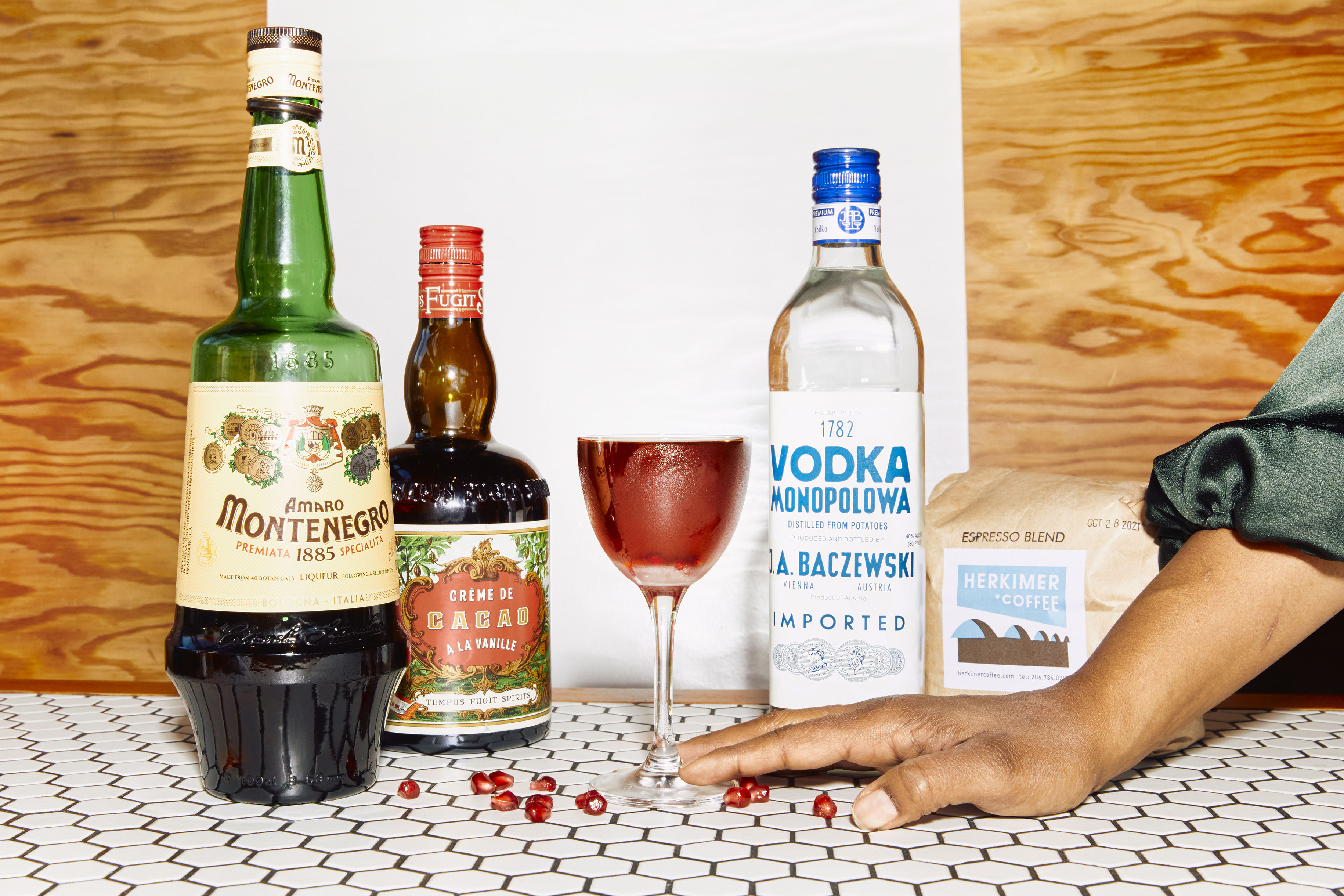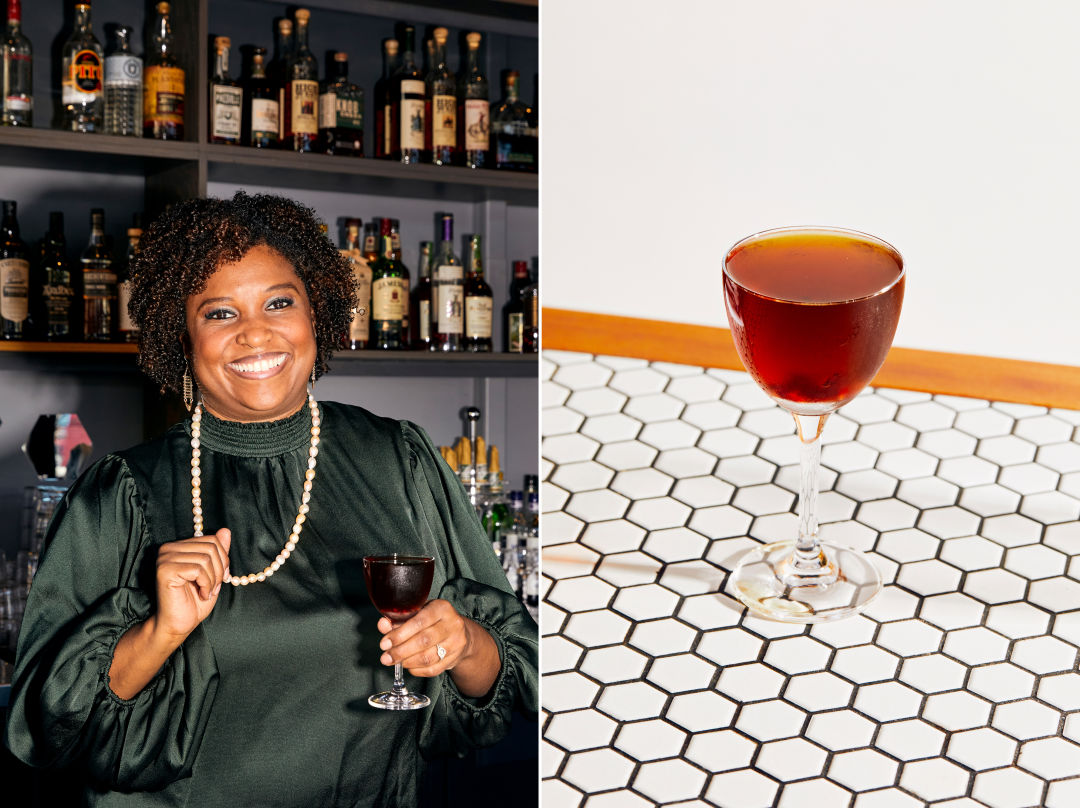
The Espresso Martini: Still All That and a Bag of Chips
Local bartenders lean on infusions, liqueurs, and sometimes even a shot of actual espresso. Photographs by Amber Fouts.
Chris Elford grips an icy cocktail shaker and applies the full force of his bartender torque, with even more zeal than usual. All that hard work produces a drink shaded a pearly brown reminiscent of a root beer float. He pours it into a coupe, then tops the cap of froth with three carefully placed coffee beans. His creation should be the cocktail equivalent of kicking up your Skechers to watch a Friends episode while crushing an Arch Deluxe.
“It drinks more old-school than it is,” he says of this espresso martini that’s a heavy seller at Trade Winds Tavern, the Belltown bar that Elford and his business partner, Anu Apte, revamped to resemble a 1980s basement rec room. The Big Buck Hunter game and Sonics memorabilia blink their own form of nostalgia, but the espresso martini is powered by memories of the 1990s.
Media to the east has chronicled the cocktail’s comeback for a while now. The New York Times deemed it “everywhere” this summer, and the zeitgeist prompted follow-up stories about how much bartenders hate making it. Pulling an espresso shot is a laborious interlude in a busy night of service; the combo of hot coffee and cold ice can make a cocktail shaker pop its top at inopportune, potentially messy moments.
Seattle participated in the espresso martini’s heyday 30 years ago. How could we not? It was the era when our city asserted its coffee dominance, and joined the vanguard of a craft cocktail movement. “Is anybody really ready for the Seattle Espresso Martini?” The Seattle Times marveled in a 1997 writeup of Tini Bigs, the then-new bar specializing in oversize libations. (Their 10-ounce version also sported that classic three-bean garnish.) The drink’s origins date back to the late 1980s and a British bartender named Dick Bradsell. As he tells it, a model approached him one night to ask, “can you make me a drink that will wake me up, and then fuck me up?”
Now, it seems, we’re participating again. Customers at Linda Derschang’s Oddfellows request the drink in droves, even though it’s not on the menu. The popularity reminds Derschang of the drink’s first go-round in the late ’90s, when she owned the Capitol Club on Pine—“we sold a million cosmos and espresso martinis.” These days, her all-day cafe pulls shots of Caffe Vita to order. The result has a satisfying cap of foam does pack the round richness—and deep, dark hue—of an actual midday espresso.
Down the hill, Pho Bac’s new cocktail hideaway, Phocific Standard Time, serves an aquavit-shaken ode to ca phe trung, Vietnam’s sweet, but pistol-packing egg cream coffee. At Roquette, a low-lit and highly legit Belltown cocktail bar, owner Erik Hakkinen played around with all sorts of coffee drinks, from “dark and brooding” to tropical riffs with passionfruit or pineapple. He found customers prefer a straight-up espresso martini—“We probably sold 30 of them last night.”

Artusi bar manager Tahlia Bolden infuses vodka with Herkimer coffee beans.
Image: Amber Fouts
Roquette’s version achieves coffee’s smooth bombast via a cold brew liqueur from Australia called Mr. Black. Its arrival in the U.S. a few years ago might have fueled the espresso martini’s return. Or at least freed bartenders from being shackled to an espresso machine. Elford’s version at Trade Winds uses this too—“we order it by the case”—with a bit of condensed milk and plain old drip. (Mr. Black, for what it’s worth, is tasty enough to drink straight, over ice.)
In other words, Seattle is participating in the espresso martini’s renaissance with very little actual espresso.
Spinasse and its next-door aperitivi bar Artusi each has its own espresso martini recipe—fitting given their Italian bona fides. New bar manger Tahlia Bolden infuses vodka with Herkimer coffee beans to make Artusi’s version. In her experience, “hot espresso melts your ice, so the drink gets watered down” in the shaker. Spinasse’s recipe uses cold brew.
“Every night there are espresso martinis coming out” at both spots, says Bolden. But after 11 years working in Seattle, she questions whether the drink has resurged—or whether it never actually left. “I feel like every bar does an espresso martini here.”
At Dreamland Bar and Diner in Fremont, manager Cera Grindstaff doesn’t have one on the official menu, but serves plenty without using an espresso machine. Dreamland makes its version with Absolut vanilla, cold brew concentrate, and Borghetti, an Italian espresso liqueur from the same company as another bartender favorite, Fernet. Orders have spiked so much this past year, Grindstaff wants to streamline the process even more: “I’m actually noodling on putting an espresso martini on nitro.”




